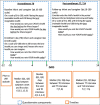Quality of life burden on United States infants and caregivers due to lower respiratory tract infection and adjusting for selective testing: Pilot prospective observational study
- PMID: 37334041
- PMCID: PMC10273330
- DOI: 10.1002/hsr2.1338
Quality of life burden on United States infants and caregivers due to lower respiratory tract infection and adjusting for selective testing: Pilot prospective observational study
Abstract
Background and aims: Policymakers need data about the burden of respiratory syncytial virus (RSV) lower respiratory tract infections (LRTI) among infants. This study estimates quality of life (QoL) for otherwise healthy term US infants with RSV-LRTI and their caregivers, previously limited to premature and hospitalized infants, and corrects for selective testing.
Methods: The study enrolled infants <1 year with a clinically diagnosed LRTI encounter between January and May 2021. Using an established 0-100 scale, the 36 infants' and caregivers' QoL at enrollment and quality-adjusted life year losses per 1000 LRTI episodes (quality-adjusted life years [QALYs]/1000) were validated and analyzed. Regression analyses examined predictors of RSV-testing and RSV-positivity, creating modeled positives.
Results: Mean QoL at enrollment in outpatient (n = 11) LRTI-tested infants (66.4) was lower than that in not-tested LRTI infants (79.6, p = 0.096). For outpatient LRTI infants (n = 23), median QALYs/1000 losses were 9.8 and 0.25 for their caregivers. RSV-positive outpatient LRTI infants (n = 6) had significantly milder QALYs/1000 losses (7.0) than other LRTI-tested infants (n = 5)(21.8, p = 0.030). Visits earlier in the year were more likely to be RSV-positive than later visits (p = 0.023). Modeled RSV-positivity (51.9%) was lower than the observed rate (55.0%). Infants' and caregivers' QALYs/1000 loss were positively correlated (rho = 0.34, p = 0.046), indicating that infants perceived as sicker imposed greater burdens on caregivers.
Conclusions: The overall median QALYs/1000 losses for LRTI (9.0) and RSV-LRTI (5.6) in US infants are substantial, with additional losses for their caregivers (0.25 and 0.20, respectively). These losses extend equally to outpatient episodes. This study is the first reporting QALY losses for infants with LRTI born at term or presenting in nonhospitalized settings, and their caregivers.
Keywords: RSV; caregiver; lower respiratory tract infection; quality of life; quality‐adjusted life year (QALY); respiratory syncytial virus.
© 2023 The Authors. Health Science Reports published by Wiley Periodicals LLC.
Conflict of interest statement
Christopher B. Nelson is an employee of Sanofi and may hold shares and/or stock options in the company. All other authors received grant funding from Sanofi and AstraZeneca (through Sanofi). Kimberley A. Fisher, Charles T. Wood, William F. Malcolm received grant funding for this study from Sanofi and AstraZeneca through Clinetic. Donald S. Shepard has received financial support from Abbott, Inc, Takeda Vaccines, Inc. and Trustees of Columbia University, New York, in the past 36 months. Dhwani Hariharan, William H. Crown and V.S. Senthil Kumar have received financial support from Bill & Melinda Gates Foundation and The Global Fund to Fight AIDS, Tuberculosis and Malaria, in the past 36 months.
Figures



Similar articles
-
Impact of Respiratory Syncytial Virus on Child, Caregiver, and Family Quality of Life in the United States: Systematic Literature Review and Analysis.J Infect Dis. 2022 Aug 15;226(Suppl 2):S236-S245. doi: 10.1093/infdis/jiac183. J Infect Dis. 2022. PMID: 35968873 Free PMC article.
-
Risk Analysis of Respiratory Syncytial Virus Among Infants in the United States by Birth Month.J Pediatric Infect Dis Soc. 2024 Jun 28;13(6):317-327. doi: 10.1093/jpids/piae042. J Pediatric Infect Dis Soc. 2024. PMID: 38738450 Free PMC article.
-
Predictors of RSV LRTI Hospitalization in Infants Born at 33 to 35 Weeks Gestational Age: A Large Multinational Study (PONI).PLoS One. 2016 Jun 16;11(6):e0157446. doi: 10.1371/journal.pone.0157446. eCollection 2016. PLoS One. 2016. PMID: 27310438 Free PMC article.
-
Incidence of Respiratory Syncytial Virus-Associated Lower Respiratory Tract Infection Until 6 months of Corrected Age in Preterm Infants with Bronchopulmonary Dysplasia: A Pilot Prospective Cohort Study.Indian J Pediatr. 2025 Jun 5. doi: 10.1007/s12098-025-05577-9. Online ahead of print. Indian J Pediatr. 2025. PMID: 40471395
-
Clinical relevance of prevention of respiratory syncytial virus lower respiratory tract infection in preterm infants born between 33 and 35 weeks gestational age.Eur J Clin Microbiol Infect Dis. 2008 Oct;27(10):891-9. doi: 10.1007/s10096-008-0520-8. Epub 2008 Jul 16. Eur J Clin Microbiol Infect Dis. 2008. PMID: 18629558 Review.
References
LinkOut - more resources
Full Text Sources

